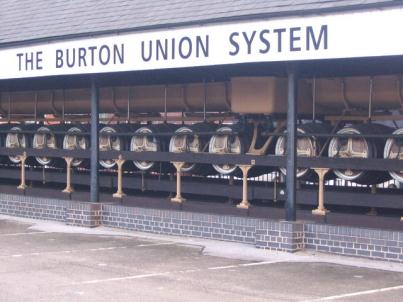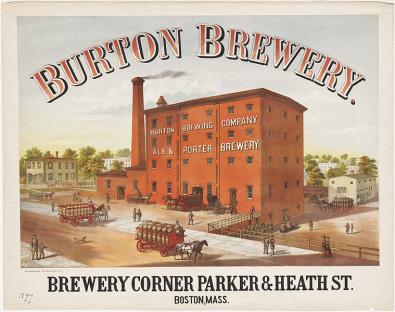

|
 A beer described in ‘Word for Word‘ (Whitbread & Co, 1953) as “a strong ale, dark in colour, made with a proportion of highly dried or roasted malts. It is not necessarily brewed in Burton, and the term is in general use for all varieties of ‘strong’ or ‘old’ ales.” Brewing in Burton-on-Trent originally grew up around the Abbey of Saint Modwen, and has become distinguished due to the water and to an unusual method of manufacture. By 1888 there were 31 breweries in the town and the distinctive taste had been identified as being caused by calcium sulphate, so that brewers elsewhere began adding ‘Burtonising Salts’ to their own brews. There are still five breweries in Burton, but only Marston’s continues to use the curious ‘Burton Union’ system, where the fermenting beer passes through a complex system of troughs and casks, in use for so long that a distinct variety of yeast has evolved.  The Burton Union System at the Coors Visitor Centre (formerly the Bass Museum). Image: Dave Pickersgill The distinctive brewing system and water means that it is not easy to reproduce Burton beer elsewhere, but this receipt is known from a time when many other brewers were at least trying to do so;  Original Receipt from ‘The Complete Practical Brewer‘ by Marcus Lafayette Byrn, USA, 1852 Original Receipt from ‘The Complete Practical Brewer‘ by Marcus Lafayette Byrn, USA, 1852BURTON ALE For this the richest malt is requisite such as will produce an extract of from eighty to eighty five pounds per quarter gravity Not more than one and a half or one and three quarter barrel of this luscious ale should be drawn from a quarter Heat of the first mash 180° Second mash 190° Third mash for return or table beer. Hops of very superior quality from six to eight pounds per quarter. Boil the first mash one hour and the second two hours pitch at 58° with eighteen pounds of yeast to every ten barrels. Attenuation must be carried on till reduced to twenty pounds per barrel and the heat increased to 70° and 75°. Then skim and cleanse  Burton was widely imitated Advertisement from the ‘Burton Brewery’ of Boston, USA, 1877 Image: Boston Public Library  |
|
MORE FROM Foods of England... Cookbooks ● Diary ● Index ● Magic Menu ● Random ● Really English? ● Timeline ● Donate ● Royalty ● English Service ● Food Map of England ● Lost Foods ● Accompaniments ● Biscuits ● Breads ● Cakes and Scones ● Cheeses ● Classic Meals ● Curry Dishes ● Dairy ● Drinks ● Egg Dishes ● Fish ● Fruit ● Fruits & Vegetables ● Game & Offal ● Meat & Meat Dishes ● Pastries and Pies ● Pot Meals ● Poultry ● Preserves & Jams ● Puddings & Sweets ● Sauces and Spicery ● Sausages ● Scones ● Soups ● Sweets and Toffee ● About ... ● Bookshop ● Email: [email protected] COPYRIGHT and ALL RIGHTS RESERVED: © Glyn Hughes 2022 BUILT WITH WHIMBERRY |